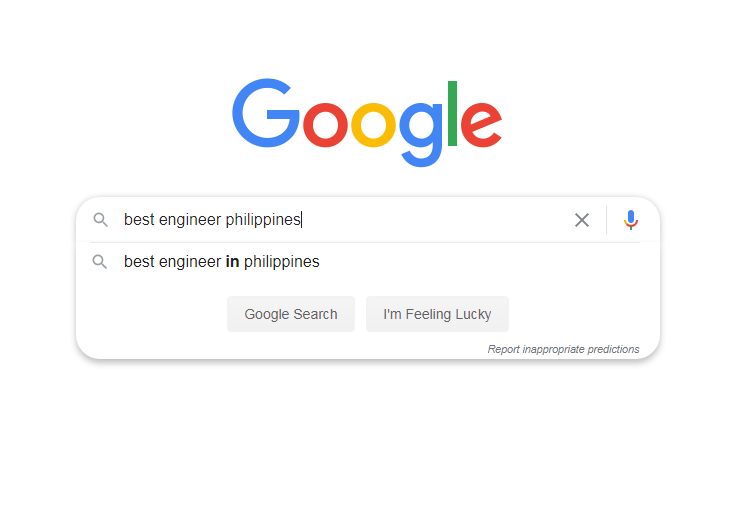How Google Autocomplete Works and How It can be Used for SEO
An average of 3.5 billion a day. That’s how many searches happen on Google according to a Google Search Statistic. With that many searches happening, Google aims to optimize a user’s search experience by delivering or suggesting what the user might search for before they finish typing which will lower the user’s typing time as well. That’s the primary purpose of Google’s Autocomplete. Although this feature is catered to the users, it poses a lot of advantages to SEOs and webmasters that thoroughly understand how it works and how it can be used to improve a website’s search performance.
What is Google Autocomplete?
Autocomplete is a Google Search feature where the search box shows possible words that might complete a user’s query. It’s a simple feature but it helps users save time by lowering their typing time and it also gives them new ideas of what related queries to search for. This is what it looks like:

To help users and webmasters understand how Autocomplete works and how it knows which terms should be suggested, Google’s Public Liaison for Search, Danny Sullivan, published a blog post on this specific topic.
To summarize the article, Google uses a variety of factors to come up with the most relevant and accurate suggestions. The factors are as follows:
- Common and Trending Queries – These are the timely queries/words often associated with the words entered by the user in the search box
- Language and Location of the User – To make more tailor-fit suggestions to the users, Google also considers their location and the language they use
- Freshness – Lastly, Google considers freshness as well. Do the words typed by the user correspond to a recent issue, news, or update that’s well-known? This also changes the suggestions shown by Google
Although it sounds simple, Google Autocomplete gives SEOs and webmasters a lot of benefits with one of the most foundational facets that is still widely used today.
How to use Google Autocomplete for SEO
Google Autocomplete is one of the best places to find valuable long-tail keywords. This is because Google Autocomplete is free, easily accessible, and based on our experiences, effective. A big part of keyword research is effectively reduced but before you use it as a keyword research tool, you have to do a couple of things first:
- Use Incognito mode – This stops Google search from using your search history and cookies to influence your autocomplete suggestions.
- Use your target audience – If you’re trying to target an audience from a different location, use a VPN and set it to your target location. By doing this, you’ll be able to see suggestions that are catered to that specific location. This applies to language settings as well. If you’re targeting a location that doesn’t use English as a native language, use their language as well to influence the suggestions. Just a little tip, if you’re not well-versed in the language you’re trying to target, don’t force it. Get someone fluent in the language to help out in understanding the suggestions, search results, and the intent of the keyword instead of relying on inaccurate translation tools.
Using Google Autocomplete isn’t as simple as it sounds though. There’s a lot of tactics you can use if you’re not happy with the suggestions you’re seeing. The initial process of typing the topic or keyword is simple, but knowing how to use it to its full capacity is another story.
So, here’s what you can do to fully take advantage of Google Autocomplete:
Play around with the text cursor
Changing the position of the text cursor in the search bar changes the suggestions that Google displays. Here’s an example using “best engineer philippines” (not a good keyword) as the keyword:

Notice the text cursor at the end, so it only shows one autocomplete suggestion. But when I move the text cursor to the middle, this happens:

When I moved the text cursor to the middle, just in front of the word “engineer”, the suggestions changed and it showed more suggestions than the initial keyword. It also stands to reason that the suggestions will change if you move the text cursor to another different position. I tried it out and it definitely changed.
Change the letter
Much like the changing of the text cursor, changing the last letter you typed is effective in changing the suggestions. Here are screenshots using the same keyword but only typing in the “best engineer” then random letters after that.

Again, different suggestions show up if I only type in the letter P instead of the whole “Philippines” bit. Let’s take a look at the suggestions when I type in a completely random letter:

If you have noticed, every time the suggestions change, the intent that the suggested keywords have changed as well. The queries suggested initially when I typed in the letter P is completely different from the suggestions when I typed the letter Q.
Key takeaway
The different tactics highlighted above enables me to find useful long-tail keywords in a short amount of time. Aside from that, it also allows me to find different variations of the same keyword or relevant keywords for topics that I’m writing about that I can use for other strategies like topic clusters, etc.
Using Google Autocomplete is one of the most effective tactics that we’ve used lately since once we find queries or keywords we’re happy with, it’s easy enough to run it through different keyword research tools that can provide the data we need for the keyword/query.
What about you? Do you use Google Autocomplete for your keyword research process? Let me know in the comments below.
